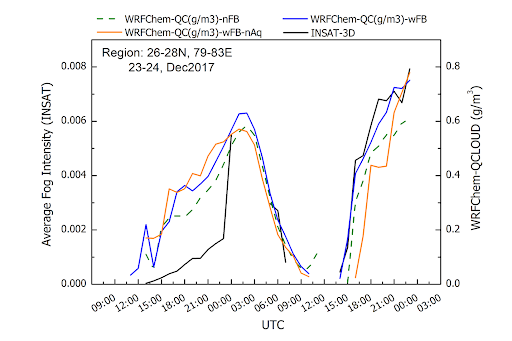Case Study of Aerosol-Fog Interactions in India
India, especially the Indo Gangetic Plain (IGP) where Delhi lies, experiences dense and widespread fog events during winter. The fog events reduce visibility to less than 200 m and worsen air pollution. Aerosols can affect fog formation, morphology, and duration through their impacts on radiation and cloud drop activation. To understand the contribution of aerosol feedback on radiation and therefore fog events, Chandrakala Bharali (Dibrugarh University, visiting Fulbright-Kalam postdoctoral scholar in ACOM and RAL) conducted simulations with the Weather Research and Forecasting model coupled with chemistry (WRF-chem) for a case study during 20 – 24 December 2017 when the Winter Fog Experiment (WiFEX) occurred.
The WRF-Chem model simulations were evaluated with satellite and surface monitoring stations located throughout the IGP. Evaluation of meteorology parameters like surface wind speed, temperature, and relative humidity showed that the global reanalysis dataset used for initial and boundary conditions was important, with the ERA-Interim dataset giving the best representation of relative humidity, a key parameter for producing fog. Comparisons of aerosol optical depth with MODIS satellite data and particulate matter with diameter less than 2.5 µm (PM2.5) concentrations with the Indian Central Pollution Control Board (CPCB) surface measurements showed good agreement between model and observations. However, a comparison of the aerosol composition (i.e., aerosol sulfate, ammonium, nitrate, chloride, organic and black carbon) with WiFEX ground-based observations revealed substantial differences, indicating that there may be missing processes included in aerosol production in WRF-Chem.
WRF-Chem simulations were conducted to examine how aerosol feedbacks on radiation affected fog formation. Two simulations were performed, one with aerosol-radiation feedbacks and one without. These results show that the aerosols in the boundary layer weakens the turbulence of the boundary layer, reducing the PBL height. The resulting smaller volume of the PBL increases the PM2.5 concentration and relative humidity near the surface while decreases the surface temperature. Thus, fog formation is favored by the presence of aerosols. Fog events began sooner by ~2 hours with aerosol-radiation feedbacks and contained ~10% more liquid water at the peak of the fog event (see Figure 1). The impact of aqueous-phase cloud chemistry was also tested, showing its impact on sulfate aerosol production. Aqueous-phase chemistry increased PM2.5 concentrations and the liquid water content in fogs. All three WRF-Chem simulations reproduced the time period of fog compared to the INSAT satellite observations with the simulation including aerosol-radiation feedbacks and aqueous chemistry giving the best representation.
